Related Research Articles

Gwangmyeong is a city in Gyeonggi Province, South Korea. It borders Seoul to the east, north and northeast, Anyang to the southeast, Siheung to the southwest, and Bucheon to the northeast.
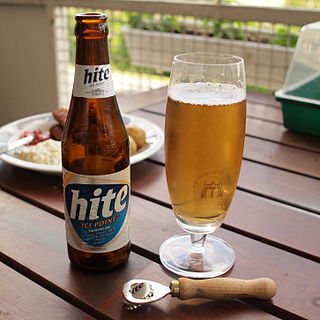
Hite Brewery Company Limited is a South Korean brewery company headquartered in Yeongdeungpo-gu, Seoul. Its main products are beer, rice wine, and mineral water.

Yeongdeungpo District is an administrative district in southwest Seoul, South Korea. Although the origin of the name is uncertain, the first two syllables are thought to be from "yeongdeung" (靈登) or "divine ascent", a shamanic rite. The third syllable is "po", representing the bank of a river (浦), referring to the district's position on the Han River. The 2006 population was 408,819.

Yeouido is a river island on the Han River in Seoul, South Korea. It is Seoul's main finance, media, and investment banking district. It is 8.4 square kilometres (3.2 sq mi) large and has a population of 32,674 as of August 2023.

Seongdong District (Seongdong-gu) is one of the 25 gu which make up the city of Seoul, South Korea. It is situated on the north bank of the Han River. It is divided into 20 dong (neighbourhoods).

Dongjak District (Korean: 동작구) is one of the 25 gu (districts) that make up the city of Seoul, South Korea. Its name was derived from the Dongjaegi Naruteo Ferry, on the Han River which borders the district to the north. It was the 17th gu created in Seoul, after being separated from Gwanak District on 1 April 1980.

Gwangjin District is one of the 25 districts of Seoul, South Korea. It is located on the north bank of the Han River on the eastern end of Seoul. The district was split from the neighboring Seongdong District in 1995.
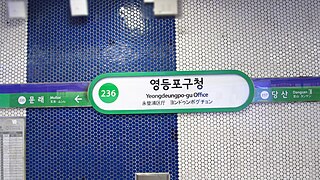
Yeongdeungpo-gu Office station is a station on Seoul Subway Line 2 and Seoul Subway Line 5. Before Mok-dong station on Line 5 was completed, this station served as a link to that neighbourhood via bus.

Yeongdeungpo station is a ground-level railway station in Seoul, South Korea. The station is located in Yeongdeungpo Dong, Yeongdeungpo-gu, and is a stop on the Gyeongbu Line, Honam Line and Seoul Subway Line 1. The station is integrated into the Yeongdeungpo Lotte Department Store. Located in the station are Lotteria, Dunkin' Donuts, Krispy Kreme, and KFC.

Yangjae-dong is a dong, neighbourhood of the greater Gangnam area Seocho District in Seoul, South Korea. Yangjae-dong is divided into 2 different dong which are Yangjae 1-dong and 2-dong.

Dangsan-dong is a dong (neighborhood) of Yeongdeungpo District, Seoul, South Korea.
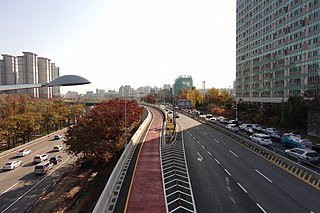
Yeoui-dong (Korean: 여의동) is a dong (neighborhood) of Yeongdeungpo-gu in Seoul, South Korea.
Yeongdeungpo-dong is a dong, neighbourhood of Yeongdeungpo-gu in Seoul, South Korea.
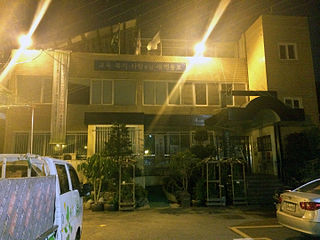
Daerim-dong is a dong (neighborhood) of Yeongdeungpo District, Seoul, South Korea.
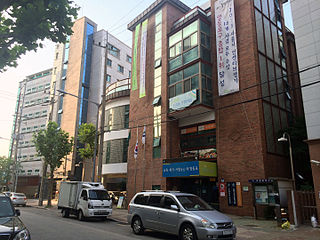
Dorim-dong is a dong (neighborhood) of Yeongdeungpo District, Seoul, South Korea.
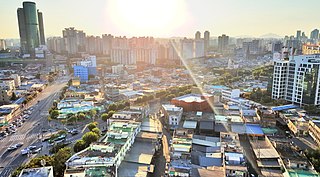
Mullae-dong (Korean: 문래동) is a dong (neighborhood) of Yeongdeungpo-gu in Seoul, South Korea. The name "Mullae" comes from the neighborhood's old name, "Moraet-mal (모랫말)," which means "Sandy Village" in Korean.
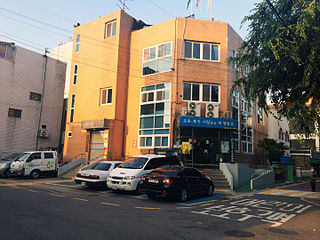
Yangpyeong-dong is a dong, neighborhood of Yeongdeungpo-gu in Seoul, South Korea.
Yanghwa-dong is a dong, neighbourhood of Yeongdeungpo-gu in Seoul, South Korea. It is a legal dong managed by its administrative dong, Yangpyeong 2-dong
Sinmunno 1-ga is a dong, neighbourhood of Jongno-gu in Seoul, South Korea. It is a legal dong administered under its administrative dong, Sajik-dong.
Siheung County, alternatively Shihŭng County was a county (gun) in Gyeonggi Province, South Korea. This county was abolished in 1989 as its one town(읍) of Sorae and two townships(면) of Gunja and Suam became Siheung City at the same time. Today's Siheung City area did not belong to Siheung County before 1914. The area rather was part of old Incheon or Ansan.
References
- 1 2 "신길동 (Singil-dong 新吉洞)" (in Korean). Doosan Encyclopedia . Retrieved 2008-04-20.
- ↑ "The origin of Singil-dong" (in Korean). Yeongdeungpo-gu official site. Archived from the original on 2008-05-29. Retrieved 2008-04-21.
